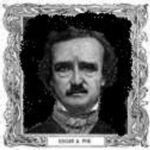On October 3, 1849, a delirious and incoherent Edgar Allen Poe was found wandering the streets of Baltimore. Upon being taken to the hospital, he was reported to have repeatedly called out the name Reynolds, although he could not explain how he came to be in such dire straits. He finally died on October 7 at the age of forty. His exact cause of death has never been determined, and the death certificate and all medical records have been lost. Over the next century and a half, numerous causes have been postulated. They range from alcoholism to heart disease to syphilis to epilepsy to cholera to rabies to meningeal inflammation. Director James McTeigue and screenwriters Ben Livingston and Hannah Shakespeare have manufactured their own reason in The Raven, a crime thriller in which a serial killer draws inspiration from Poe’s works.
On the basis of its incredibly low Rotten Tomatoes score, I seem to be one of the few that found this film clever and incredibly engrossing. I view it not as a historical reenactment, but rather as a detective story no more preposterous in plot and characterization than one of Poe’s stories. Like the author himself, the makers of this film are guilty of little more than indulging in dark fantasies for the sake of popular entertainment. In my view, they succeeded; the film is not merely a taut, complex, and suspenseful mystery but is also a triumph of art direction and cinematography, with bold colors and deep shadows populating the visual landscape. It’s also a surprisingly good character study, albeit only in regards to Poe, played with terrific emotional range by John Cusack. The remaining characters border on typecasts, although considering the genre, this is appropriate.
In the film, Poe is an emotionally broken alcoholic at the end of his career – a man who can’t come to terms with the fact that he isn’t the celebrity he should have been. His real-life status as a literary critic allows for passages of dialogue that exhibit delicious intellectual scorn. Watch early scenes in which he argues with his newspaper editor (Kevin R. McNally), and you’ll know what I’m talking about; rather than compose acidic critiques of poets such as Longfellow, he repeatedly pressures Poe to resume writing gruesome horror stories, as it’s well known that macabre fiction is what readers love. He finds solace in the love of his life, a young woman named Emily Hamilton (Alice Eve), who thinks “Annabel Lee” is one of the most romantic poems she has ever read. Her father, a retired colonel (Brendan Gleeson) despises Poe on general principles and refuses to let his daughter have any contact with him. Naturally, they meet on the sly.
Meanwhile, a police inspector named Emmett Fields (Luke Evans) is hot on the trail of a serial killer whose victims’ fates are disturbingly similar to events described in Poe’s stories. A mother and her twelve-year-old daughter, for example, are murdered in a room that was locked from the inside and had a window that was seemingly nailed shut. Fields’ familiarity with Poe’s work allows him to determine that the window is actually locked by a trick mechanism, one that, when triggered, would allow it to freely open. Poe is initially treated as a suspect, but in due time is brought on board as an advisor, as only he can make sense of the clues left at the various crime scenes. One of the victims meets his end in a rather gory reenactment of “The Pit and the Pendulum.” It’s determined that the victim is Poe’s bitter rival, literary critic Rufus Griswold. (Note: The actual Rufus Griswold was never sliced in two, although he did passionately dislike Poe, having held a grudge against him since 1842.)
Emily is kidnapped at a masked ball orchestrated by her father. At that point, every subsequent murder serves as a clue pointing to her location. As Poe and Fields desperately attempt to piece evidence together during a limited window of opportunity, we see Emily as she struggles to maintain her breathing in a very shallow coffin. Its location is not made apparent to the audience, although we do get restricted glimpses of a dark room filled with books. This is as it should be; we should be trying to solve the mystery along with the characters. Clearly inspired by “The Premature Burial,” this subplot allows for one of the film’s most effective shots, in which the camera pans from left to right so as to reveal a cross section of the coffin.
At this point, I will not describe any more of the plot, as there are twists that shouldn’t be given away. I will instead turn my attention to a conversation held during the climax, at which point we delve into the unexplainable and sometimes dangerous world of fandom. In spite of the dialogue, which was at times a bit mechanical, I was blindsided by how well the filmmakers addressed a contemporary issue within the context of historical fiction. We know that art and artists can drive a person towards madness, but we have yet to fully understand why. It’s precisely because of this that I believe The Raven is a lot smarter than most are giving it credit for. It’s also tremendous entertainment, not only because it revels in the macabre but also because, like a good detective story, it dares the audience to play along in a game of cat and mouse.
(www.atatheaternearyou.net)





